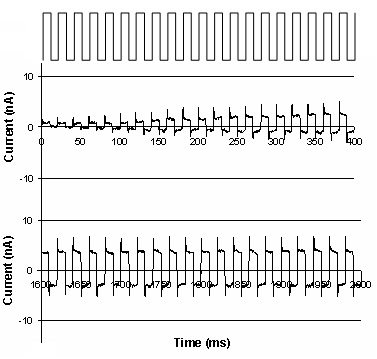Whole Cell Patch Clamp Studies
Normally, due to randomly paced pumping cycle and different pumping rate, the outward 3 Na currents and inward 2 K currents in each pump cycle from individual pumps are cancelled and only small net outward pump currents can be measured. Once synchronized, the inward and outward pump currents are separated. Right figure shows the pump synchronization process in response to the pulsed synchronization electric field (upper panel). The Na/K pump currents elicited by the first 20 oscillating pulses are shown in the middle panel. As expected, due to naturally random pace, pump currents elicited by the first a few pulses exhibit only positive (outward) currents corresponding to the positive half-pulses while very little pump current can be evoked by the negative half-pulse.

As the pulse is oscillating, inward pump currents are gradually distinguished from the outward currents showing separated negative (inward) and positive (outward) currents corresponding to the negative and positive half-pulses, respectively. When reaching stable, magnitude ratio of two currents is close to 3:2 which is shown in the lower panel responding to the 3rd 20 pulses. The results imply that naturally random paced pumps are synchronized to the applied oscillating electric field.
Selected Publications
- Chen W, Zhang ZS, Synchronization of Na/K pump molecules by a train of squared pulses. Journal of bioenergetics and biomembranes Dec;38(5-6):319-25, 2006
- Chen, W., Zhang, Z. S. and Huang, F., Entrainment of Na/K pumps by a synchronization modulation electric field. Journal of Bioenergetics and Biomembrane 39:331-339, 2007
- Chen, W., Zhang, Z.S., and Huang, F., Synchronization of Na/K pump molecules by an oscillating electric field. Journal of Bioenergetics and Biomembrane, 40:347-357, 2008